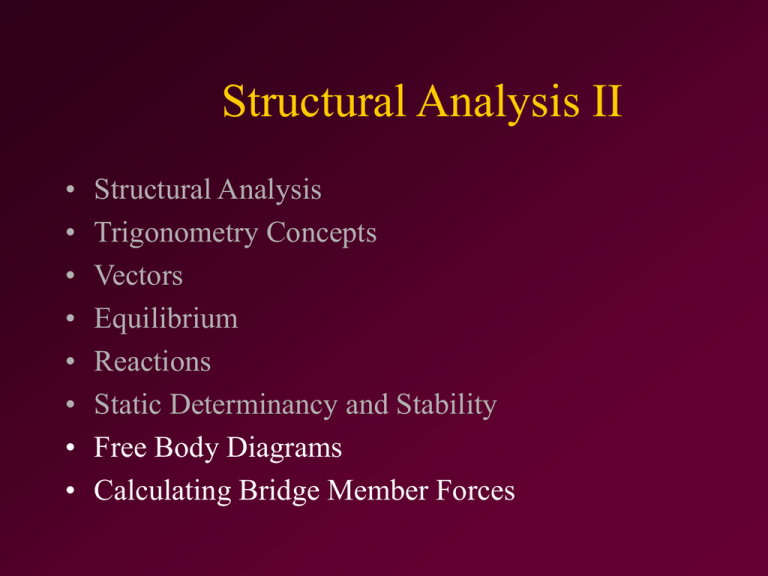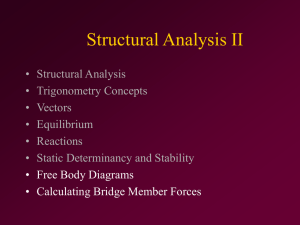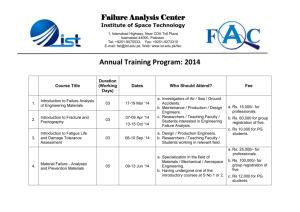ppt - MESA
advertisement

Structural Analysis II • • • • • • • • Structural Analysis Trigonometry Concepts Vectors Equilibrium Reactions Static Determinancy and Stability Free Body Diagrams Calculating Bridge Member Forces Learning Objectives • Generate a free body diagram • Calculate internal member forces using the Method of Joints Free Body Diagram • Key to structural analysis 1) Draw a simple sketch of the isolated structure, dimensions, angles and x-y coordinate system 2) Draw and label all loads on the structure 3) Draw and label reactions at each support Structural Analysis Problem • Calculate the internal member forces on this nutcracker truss if the finger is pushing down with a force of eight newtons. Structural Analysis Solution Draw the Free Body Diagram Step 1: Draw simple sketch with dimensions, angles, and x-y coordinate system c y x 40o 70o a Nutcracker truss formed by tied ends 70o b Corresponding sketch Structural Analysis Solution Draw the Free Body Diagram Step 2: Draw and label all loads on the structure 8N y c x 40o 70o a Nutcracker truss with 8N load 70o b Added to free body diagram Structural Analysis Solution Draw the Free Body Diagram Step 3: Draw and label all reactions at each support • The truss is in equilibrium so there must reactions at the two supports. They are named Ra and Rb. 8N y c x 40o 70o a Ra 70o b Rb Structural Analysis Solution Method of Joints • Use the Method of Joints to calculate the internal member forces of the truss 1. Isolate one joint from the truss 2. Draw a free body diagram of this joint 3. Separate every force and reaction into x and y components 4. Solve the equilibrium equations 5. Repeat for all joints Structural Analysis Solution Method of Joints y Step 1: Isolate one joint Step 2: Draw the free body diagram 8N x c y 40o 70o a Ra = 4N 70o b Rb = 4N Fac a c 70o Fab b Ra = 4N x Structural Analysis Solution Method of Joints Step 3: Separate every force and reaction into x and y components y First analyse Ra • x-component = 0N • y-component = 4N a x Ra = 4N Structural Analysis Solution Method of Joints Step 3: Separate every force and reaction into x and y components y Next analyse Fab • x-component = Fab • y-component = 0N a Fab b x Structural Analysis Solution Method of Joints Step 3: Separate every force and reaction into x and y components y Lastly, analyse Fac • x-component = Fac*cos70˚ N • y-component = Fac*sin70˚ N Fac a c 70o x Summary of Force Components, Node ‘a’ Force Name Free Body Diagram x- component y-component Ra y a Fab Fac y c y x Ra = 4N 0N 4N x Fab Fab 0N Fac a 70o x Fac * cos70˚ N Fac * sin70˚ N Structural Analysis Solution Method of Joints Step 4: Solve y-axis equilibrium equations • The bridge is not moving, so ΣFy = 0 • From the table, ΣFy = 4N + Fac * cos70˚ = 0 • Fac = ( -4N / cos70˚ ) = -4.26N • Internal Fac has magnitude 4.26N in compression Structural Analysis Solution Method of Joints Step 4: Solve x-axis equilibrium equations • The bridge is not moving, so ΣFx = 0 • From the table, ΣFx = Fab + Fac * sin70˚ = 0 Fab = - ( -4.26N / sin70˚ ) = 1.45N • Internal Fab has magnitude 1.45N in tension Structural Analysis Solution Method of Joints Tabulated Force Solutions Member Force Magnitude AB 4.26N, compression BC 1.45N, tension AC (not yet calculated) Structural Analysis Solution Method of Joints Step 5: Repeat for other joints Step 1: Isolate one joint Step 2: Draw the free body diagram y 8N x y 8N c c 40o Fac = -4.26N 70o a 70o 40o b a Ra Fbc x Rb b Structural Analysis Solution Method of Joints Step 3: Separate every force and reaction into x and y components y First analyse Rc • y-component is -8N • x-component is 0N 8N c x Structural Analysis Solution Method of Joints Step 3: Separate every force and reaction into x and y components y Next analyse Fac • x-component is –(Fac * sin20˚) = - (-4.26N * 0.34) = 1.46N c Fac 20o • y-component is –(Fac * cos20˚) = - (-4.26N * 0.94) = 4.00N a x Structural Analysis Solution Method of Joints Step 3: Separate every force and reaction into x and y components y Lastly analyse Fbc • y-component = –(Fbc * cos20˚) c x Fbc • x-component = (Fbc * sin20˚) 20o b Summary of Force Components, Node ‘c’ Force Name Free Body Diagram Rc 8N c Fac Fbc c c Fac 20o a x- component y-component 0.00 N -8.00 N 1.46 N 4.00 N Fbc 20o b Fbc * sin20˚ N -Fbc * cos20˚ N Structural Analysis Solution Method of Joints Step 4: Solve y-axis equilibrium equations • The bridge is not moving, so ΣFy = 0 • From the table, ΣFy = -8.00N + 4.00N - Fbc * cos20˚ = 0 Fbc = -4.26N • Internal Fbc has magnitude 4.26N in compression Structural Analysis Solution Method of Joints Step 4: Solve x-axis equilibrium equations • The bridge is not moving, so ΣFx = 0 • From the table, ΣFx = 1.46N + Fbc * sin20˚ = 0 Fbc = -4.26N • This verifies the ΣFy = 0 equilibrium equation and also the symmetry property Structural Analysis Solution Method of Joints Tabulated Force Solutions Member Force Magnitude AB 4.26N, compression BC 1.45N, tension AC 4.26N, compression Acknowledgements • This presentation is based on Learning Activity #3, Analyze and Evaluate a Truss from the book by Colonel Stephen J. Ressler, P.E., Ph.D., Designing and Building File-Folder Bridges



